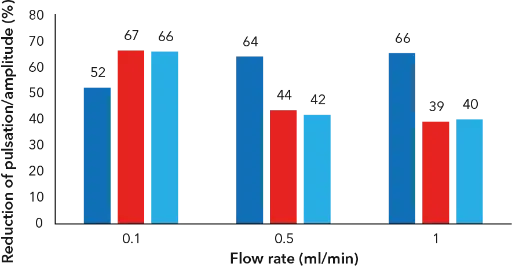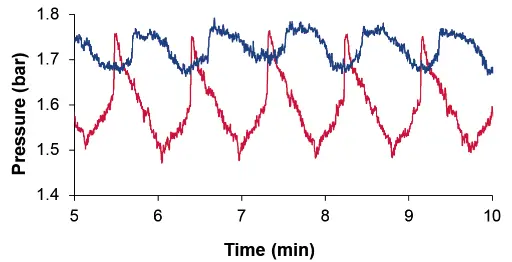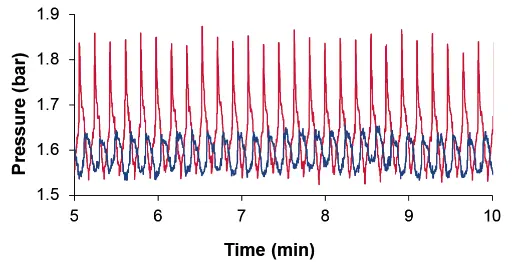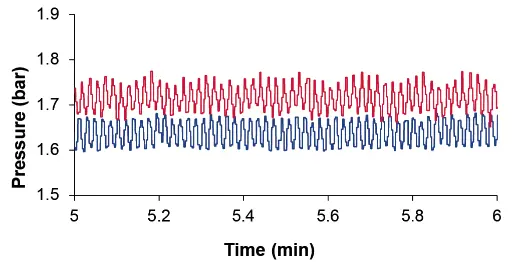
Science with Passion
Application No.: VTN0020 Version 1 09/2021
Evaluation of a pulse damper for FPLC systems with a P 6.1L pump
Ulrike Krop, Florian Glauche, Kate Monks; applications@knauer.net
KNAUER Wissenschaftliche Geräte GmbH, Hegauer Weg 38, 14163 Berlin

Photo: KNAUER
Summary
Pressure fluctuations caused by pump pulsation can present a challenge in FPLC, especially when working with pressure-sensitive columns. Here we analyzed the performance of the KNAUER PEEK pulse damper in combination with the AZURA® P 6.1L pump. The pulse damper was able to reduce pressure pulsation by up to 67 % at small flow rates. The best working conditions for the pulse damper were determined at flow rates below 1ml/min in combination with a minimum back pressure of approximately 1.5 bar. At flow rates above 1ml/min, the dampening efficiency decreases significantly.
Introduction
Piston pumps are the standard solution for buffer delivery in FPLC systems. Although they are very reliable and require low maintenance, residual pulsation cannot be fully prevented. Some applications and columns are highly sensitive to the pump’s residual pulsation. Stable pressure is not only crucial for a robust UV baseline but more importantly for the life span of both the column and the packing. The addition of a pulse damper to a system can be used to improve the baseline and minimize pressure impulses. The KNAUER PEEK pulse damper combines high damping performance with a reliable, membrane-free assembly and can be easily integrated into AZURA FPLC systems. In comparison to the P 4.1S pump, the P 6.1L pump features active pulsation compensation. In this study, we evaluated the benefit of our pulse damper with the P 6.1L and FPLC systems and give recommendations for their use.
Results
The pulsation of the P 6.1L pump was compared with and without the use of the PEEK pulse damper. The relative reduction of pulsation for different flow rates and different back pressures are listed in Tab. 1 and additionally depicted in Fig. 1. A reduction of over 60 % was reached at a flowrate of 0.1 ml/min with a back pressure of 4.5 and 10 bar and with flow rates of 0.5 ml/ min and 1 ml/min and a back pressure of ~1.5 bar. Fig. 2 illustrates the effect of the pulse damper on four external pressure signals, with and without a pulse damper, at different flow rates with ~1.5 bar back pressure. To function correctly the KNAUER pulse damper needs back pressure of at least 1–2 bar (data without back pressure not shown). Higher flow rates of the P 6.1L above 1ml/min reduced the pulsation of the pump and therefore, consequently, the effect of the pulse damper (Fig. 2 D). The total pulsation with respect to the pressure is already low in comparison with the pump P 4.1S (see. TechNote VTN0019) therefore the pulse damper is only recommended for small flow rates below 1ml/min.
Tab. 1 Percent reduction of the relative pulsation for different flow rates and different back pressure with water
Flow rate | Back pressure | Reduction of pulsation (%) |
0.1 | 1.5 | 52 |
0.1 | 4.5 | 67 |
0.1 | 10 | 66 |
0.5 | 1.5 | 64 |
0.5 | 4.5 | 44 |
0.5 | 10 | 42 |
1 | 1.5 | 66 |
1 | 4.5 | 39 |
1 | 10 | 40 |

Fig. 1 Comparison of the relative reduction of the pulsation for different flow rates and different back pressure (dark blue) ~1.5 bar; (red) ~4.5 bar (light blue) ~10 bar with water
(A)

(B)

(C)

(D)

Fig. 2 Overlay of the external pressure signal at different flowrates, approx. 1.5 bar back pressure and water as eluent. Pressure signal without pulse damper (red), pressure signal with pulse damper (blue); (A) 0.1 ml/min; (B) 0.5 ml/min; (C) 1ml/min; (D) 5 ml/min
Conclusion
The biocompatible pulse damper was able to reduce pressure pulsation by up to 67 % at small flow rates. The best working conditions for the pulse damper were determined at flow rates below 1 ml/min in combination with a minimum back pressure of approximately 1.5 bar. At flow rates above 1 ml/min the pulse damper shows no benefit in reducing the pressure pulsation. The flow scheme and the capillary connection of the exemplary isocratic P 6.1L and the pulse damper are shown in Fig. 3. For most applications, the use of the pulse damper is not recommended when using the P 6.1L pump. Only when using very sensitive columns operating at low flow rates or performing analytical methods where baseline stability is important the pulse damper is beneficial. Care should be taken using gradient methods like ion exchange or hydrophobic interaction chromatography as the pulse damper increases the gradient delay or dwell volume of the system by 275 µl. Isocratic methods like size exclusion chromatography are not effected by the extra volume of the pulse damper.

Fig. 3 Connection scheme of AZURA P 6.1L with pulse damper
Materials and Methods
Method
The pressure measurements were performed using an external pressure sensor. The pulse damper was installed behind the pump, followed by the external pressure sensor and a back pressure regulator. Testing was performed at various back pressures (w/o back pressure; approx. 1.5 bar; approx. 4.5 bar and approx. 10 bar). The following flow rates were tested: 0.05; 0.1; 0.5; 1 and 5 ml/min. The pressure signal of the external pressure sensor was recorded for 15 minutes. In addition, the flow was monitored with a flowmeter. The mean pressure was determined over a period of 10 minutes. The amplitude/pulsation was obtained from the difference of the max/min value over a period of 10 minutes. The relative reduction of the pulsation/amplitude was set in relation to the mean pressure value.
Tab. 2 Method parameters for the analysis of pulsation
Method parameter | |
Eluent (A) | Water or 90/10 Water/Ethanol |
Flow rate | 0.05; 0.1; 0.5; 1 or 5 ml/min |
Back pressure | w/o, ~1.5; ~4.5 or ~10 bar |
Detection | External pressure sensor, flowmeter |
Data rate | 20 ms/50 Hz |
Temperature | RT |
System configuration
Tab. 3 System and devices used for the analysis of pulsation of the pressure signal
Instrument | Description | Article No. |
Pump | AZURA P 6.1L High Pressure Pump with 50 ml pump head, Ceramic, without Degasser | |
External pressure sensor | Biocompatible Pressure Sensor | |
IFU Box | Interface Box IFU 2.1 LAN, 4 channels, LAN connection, including accessories | |
Distribution Box | Distribution Box 24 V for auxiliary equipment power supply 24 V for up to 6 peripheral devices | |
Pulse damper | Pulse Damper, High Volume, PEEK | |
Back pressure regulator | Back-Pressure Regulator 1–20 bar | A70087 |
Flowmeter | Mini CORI-Flow (M13) Mass flow meter/controller, 1–50 ml/min | |
Flowmeter | Mini CORI-Flow (M12) Mass flow meter/controller, 0.03–3.3 ml/min | |
Software | Purity Chrom basic |
Related KNAUER Applications
VTN0002 – Performance evaluation of KNAUER pulse dampers in comparison to competitive dampers
VTN0019 – Reduce pulsation – improve performance and increase longevity of your column using the pulse damper with the AZURA SEC FPLC System
Application details
|
Method |
FPLC |
|
Mode |
SEC |
|
Substances |
n/a |
|
CAS number |
n/a |
|
Version |
Application No.: VTN0020 | Version 1 09/2021 | ©KNAUER Wissenschaftliche Geräte GmbH |


